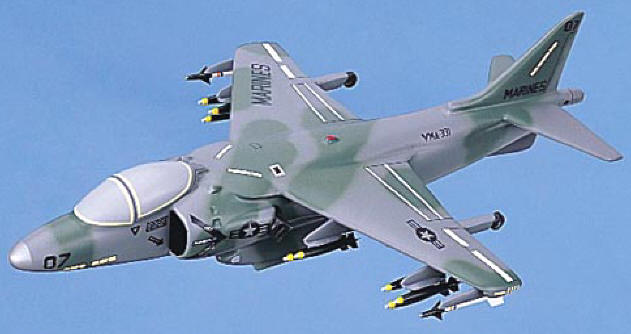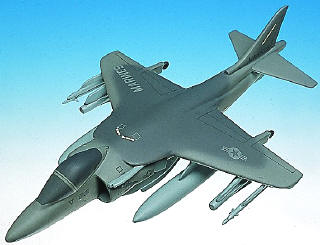|
|
|
 |
McDonald-Douglas AV-8B Harrier II |
 |
The dream for a military aircraft able to take-off and land
vertically like a helicopter and then transition to conventional
flight was realized in the British made AV-8A Harrier. First flown
and deployed by the RAF in 1969, it utilizes the concept of
"Vectored Thrust" in which turbine by-pass air is routed to one of
two pairs of nozzles at the wing roots, while jet exhaust is
directed through the second pair. The combined "thrusts"
enable the Harrier to either hover or fly normally depending on
the position of the nozzles which can be rotated in unison along
the longitudinal axis anywhere from straight aft for forward
flight to a little forward of straight down for hover.
Designed primarily for ground attack and support carrying all
armament under the wings, it is also capable of near supersonic
speeds (approximately 600 knots). Harriers were tested in combat
during the Falkland Islands War during which 42 were deployed for
ground support, air defense, ship strikes, and reconnaissance.
They shot down at least 20 enemy planes most with Sidewinders and
some with 30 mm, without a single air-to-air loss. Five were lost
to ground fire and four to adverse weather. It is said that the
British victory probably would not have happened without the
Harriers.
The U.S. Marine Corps formed its first
squadron in April, 1971. These aircraft were basically the same as
the RAF Harriers but with American avionics, flight control
systems and weapons systems. The last of this batch was delivered
in 1976, and the last AV-8A was retired in 1986. Reluctant
to have our military aircraft manufactured outside of the U.S., a
licensing agreement was made between Hawker-Siddley and
McDonnell-Douglas for the manufacture of the follow-on AV-8B
(Harrier II) designed to give the Harrier the payload, range, and
accuracy of the most modern conventional aircraft. Testing was so
successful that the initial production order of 12 AV-8Bs was
placed before the program was completed, and delivered to the
Marines in January, 1984. While outwardly resembling the earlier
Harriers, the AV-8B is a new and totally different aircraft that
incorporates a higher thrust engine (21,500 lbs vs 20,000 lbs)
giving about the same speed, but a much greater payload. It has a
new supercritical wing holding more fuel and with six payload wing
pylons instead of four, plus a fuselage station. The cockpit is
entirely different, being similar to the F/A-18, with state of
the-art electronics and a bubble canopy for better visibility.
During Desert Storm operations, four USMC
Harrier squadrons (86 aircraft), operating from land and shipboard
bases, flew 3,380 sorties for 4,038 hours, and delivered over 5.95
millions lbs of ordnance (mainly Rockeye cluster bombs, 500 lb
iron bombs and napalm). The Marine Corps is pleased with its
Harriers, with seven Attack Squadrons and one Training Squadron
flying them, and it is expected that they will be operational well
into the next century. Harriers are also used by the British,
Spanish, and Italian Navies.
|
|

|
AV-8B Harrier II - US
Marines
Premier Series. Loaded with weapons. 1/35th scale. 10"
wingspan x 17.5" long.
No. AGN2D-PR. Only $219.95 |
 |
AV-8B Harrier II - US
Marines
Standard Series. 1/48th scale.
7.35" wingspan x 11.25" long.
No. AGN2D-ST. Only $129.95 |
|
|
